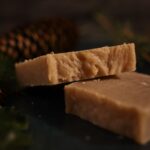Vanilla and Cinnamon Hot Process Soap Recipe
This vanilla and cinnamon hot process soap is easy to make, and smells JUST like a fresh batch of warm sugar cookies at Christmastime!
Yield: 10 soap bars
Equipment
- Crock Pot
- Soap mold
- kitchen scale
- Immersion blender
- safety glasses
- long latex gloves
- non-reactive stirring spoon
- non-reactive measuring containers
Materials
- 12 ounces coconut oil
- 12 ounces olive oil
- 4 ounces shea butter
- 4 ounces castor oil
- 12.16 ounces water
- 4.61 ounces lye (sodium hydroxide)
- 1 ounce vanilla essential oil
- .5 ounce clove essential oil
- .25 ounce cinnamon essential oil
- 1 T ground cinnamon
Instructions
Prepare your workspace
- As with all soapmaking sessions, prepare by clearing your workspace and ensuring that you have more than adequate clear counter space. Don't allow pets or children to wander through your work area.
Making this hot process soap recipe
- Start by putting all of the oils/butter into the crockpot. Set it to LOW, and allow it to warm until all of the oils are melted. The shea butter will take longest to melt, and you can give it an occassional stir to help it along.
- Weigh your water into a heat-safe, non-reactive contatiner, with plently of additional room to mix in the lye.
- In another non-reactive container, weigh out the correct amount of lye.
- Slowly pour THE LYE INTO THE WATER (never the other way around), stirring slowly until all of the lye is fully disolved into the water. The lye mixture will immediately begin to warm up. (Unlike with cold process soap, you don't have to wait for the lye mixture to cool to a certain temperature. As long as all of the oils are fully melted, you can actually pour the lye into the oils as soon as it's mixed.)
- Carefully pour the lye mixture into the melted oils.
- As soon as the lye is poured into the melted oils, use an immersion blender to bring the lye and oil mixture to trace. When the mixture reaches trace, you'll know, because it will look like vanilla or butterscotch pudding. When you lift the immersion blender, it will leave a gentle peak in the mixture, and any drops will linger on the surface as little blobs. It REALLY looks like pudding.
- Put on the lid of the crock pot, and let the mixture cook. You'll see the mixture start to get translucent around the edges and start to "crawl" up the side of the crock pot. Definitely give it a stir if it threatens to flow over the edges, and it doesn't hurt to give it the occassional stir even if it doesn't.
- The soap needs to cook until until it's no longer caustic, which takes about 40-50 minutes. It will go through several phases - translucent around the edges, then lumpy and cloudy looking (I've hear this called the "mashed potato stage" and it's really what it looks like!) Then the soap will start to get translucent again. It's a good idea to give the whole thing a stir about once every 10 minutes, to keep it all cooking evenly.
- When the soap starts to get evenly translucent again, you can go ahead and test it. I use the "zap test", recommended by Heidi at Healing Harvest Homestead. Take a little bit of soap between your fingers, and rub it around. Does it feel waxy? If it's feeling waxy, go ahead and touch your tonge to it. If it "zaps" and tingles your tounge, it's not quite done yet, and needs to cook a little longer. If it just tastes like soap. You're ready.
- Once the soap is done, go ahead and turn off the crock pot and remove the lid. Let the soap cool for 5 minutes. You want a little of the heat to escape before adding those wonderful essential oils.
- Now add the ground cinnamon, and the essential oils. Still well until the mixture is evenly blended.
- Now you can scoop the soap into your mold. This 2lb recipe fits perfectly into a 2lb loaf mold. (This is the one I use and love)
- Glob all of the soap right down into the mold, scraping the sides of the crock pot to get all of it. Then lift the soap mold and firmly tap it on the counter several times to release any bubbles, and make sure the soap is well tamped down into every corner of the mold. (I honestly THUMP it pretty hard on my countertops - it's not very graceful, but does an effective job at getting good solid bars of soap!)
- Now, let the soap just sit and cool for at least 8 hours, before unmolding it. If you really need to rush it, you can put it in the fridge, and get away with unmolding after about 4 hours.
- While the soap is technically read to use right away, I like to let it sit and harden for a day or two after it's unmolded, before slicing the soap loaf. Then, once it's sliced, I usually let the bars of soap sit for another day or two to harden up a little more, before I package them. That said - there's no rush to cut your loaf of soap, and it's actually a great way to store the soap if you're not using right away. You can just leave it as it is, and slice of bars of soap as you need them.
- To make your bar soap last well, be sure to use a well-draining soap dish that lets your bar dry in between washings. Sitting in a puddle of water drastically reduces the life of your soap. Enjoy!
